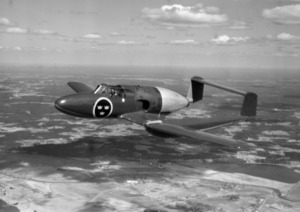| Saab 21R | |
|---|---|
 | |
| General information | |
| Type | Fighter and attack aircraft |
| National origin | Sweden |
| Manufacturer | SAAB |
| Status | Retired |
| Primary user | Swedish Air Force |
| Number built | 64 |
| History | |
| Manufactured | 1950–1952 |
| Introduction date | 1950 |
| First flight | 10 March 1947 |
| Retired | 1956 |
| Developed from | SAAB 21 |
The Saab 21R was a Swedish fighter/attack aircraft developed and produced by Svenska Aeroplan AB (SAAB). It was a jet-powered development of the piston-engined SAAB 21 and was the first jet aircraft to be produced by Saab. The R-suffix stands for reaktion (reaction), referencing reaktionsdrift (jet power) or reaktionsmotor (jet engine). Along with the Soviet Yakovlev Yak-15, the 21R was one of only two jet fighters to have been successfully converted from piston-powered aircraft.[1]
Sweden was under threat during the Second World War, and ordered SAAB to develop an advanced fighter. The result was an unorthodox twin-boom pusher, with a low wing, tricycle landing gear, and a heavy forward-firing armament. Several options were then explored to improve its performance, leading to a jet-powered version.
During 1947, SAAB began converting the piston-engined J 21s to jet propulsion, which required extensive modifications. One hundred twenty-four aircraft were planned, however this number was reduced to 64 and they were instead mainly used as fighter-bombers. It saw service in the late 1940s and early 1950s before it was replaced by a new generation of fighters designed from the onset with jet propulsion, such as the de Havilland Vampire and the Saab 29 Tunnan.
- ^ Gunston 1995, p. 472.